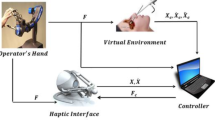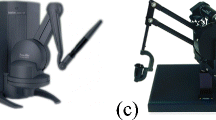Abstract
In this article, a real-time, visual and force environment for a 5-dof haptic urological training simulator is presented that deals with a low-force, high-deformation environment. A real-time graphical representation of the male urethra during the insertion of an endoscope is developed. Smooth urethra deformations are produced by a mesh of piece-wise Bézier interpolations, while its inner wall is simulated by realistic tissue textures. Efficient real-time techniques are developed that introduce endoscope camera depth-of-field effects. A novel particle-based model computes in real-time the forces fed to the haptic device. A 13 fps refresh rate is achieved on a 2-GHz computer with the depth-of-field effect activated, while the rate is doubled to 26 fps with this feature disabled. It is expected that the simulator will contribute to ethical, efficient, and modern surgical training.
Similar content being viewed by others
References
Baur C, Guzzoni D, Georg O (1998) Virgy: a virtual reality and force feedback-based endoscopy surgery simulator. Proceedings of Medicine Meets Virtual Reality, San Diego, CA, IOS Press, Amsterdam, The Netherlands, pp 110–116
Kühnapfel U, Kuhn Ch, Hübner M, et al. (1997) The Karlsruhe endoscopic surgery trainer as an example for virtual reality in medical education. Minimally invasive therapy and allied technologies, Blackwell Science Ltd., Oxford, UK, pp 122–125
Basdogan C, Ho CH, Srinivasan MA, et al. (1998) Force interactions in laparoscopic simulations: haptic rendering of soft tissues. Proceedings of Medicine Meets Virtual Reality, San Diego, CA, IOS Press, Amsterdam, The Netherlands, pp 385–391
Edwards JC, Luecke GR (1996) Physically based models for use in a force feedback virtual environment. Proceedings of the Japan/ USA Symposium on Flexible Automation, Boston, MA, ASCE, East Washington, DC, USA, pp 221–228
Brown J, Montgomery K, Latombe J, et al. (2001) A microsurgery simulation system. Proceedings of Medical Image Computing and Computer-Assisted Intervention, Utrecht, The Netherlands, Springer New York, NY, USA, pp 137–144
Ikuta K, Iritani K, Fukuyama J (2001) Mobile virtual endoscope system with haptic and visual information for non-invasive inspection training. Proceedings of the IEEE International Conference on Robotics and Automation (ICRA 2001), Seoul, Korea, IEEE, Piscataway, NJ, USA, pp 2037–2044
Bianchi G, Solenthaler B, Szekely G, et al. (2004) Simultaneous topology and stiffness identification for mass-spring models based on fem reference deformations. Proceedings of Medical Image Computing and Computer-Assisted Intervention (MICCAI 2004), St-Malo, Springer New York, NY, USA, pp 293–301
Weiss DJ, Okamura AM (2004) Haptic rendering of tissue cutting with scissors in a virtual environment. Proceedings of Medicine Meets Virtual Reality Conference, Newport Beach, IOS Press, Amsterdam, The Netherlands, pp 157–163
Li M, Liu Y-H (2005) Modeling interactions of pulpal tissue with deformable tools in endodontic simulation. Proceedings of the IEEE International Conference on Robotics and Automation (ICRA 2005), Barcelona, Spain, IEEE, Piscataway, NJ, USA, pp 2637–2642
Chen P, Steiner KV, Barner KE (2006) Toward realistic soft tissue modeling for virtual surgery simulations. University of Delaware Computational Science Day, Newark, 2006, University of Delaware, Newark, DE, USA
DiMaio SP, Salcudean SE (2002) Needle insertion modelling and simulation. Proceedings of the IEEE International Conference on Robotics and Automation (ICRA 2002), Washington, DC, IEEE, Piscataway, NJ, USA, pp 2098–2105
De S, Srinivasan MA (1999) Thin-walled models for haptic and graphical rendering of soft tissues in surgical simulations. In: Westwood JD, et al. (eds) Medicine meets virtual reality. IOS Press, Amsterdam, The Netherlands, pp 94–99
Basdogan C, Ho C, Srinivasan MA (2001) Virtual environments for medical training: graphical and haptic simulation of laparoscopic common bile duct exploration. IEEE/ASME Trans Mechatron 6:269–285
De S, Kim J, Manivannan M, et al. (2002) Multimodal simulation of laparoscopic Heller myotomy using a meshless technique. In: Westwood JD, et al. (eds) Medicine meets virtual reality. IOS Press, Amsterdam, The Netherlands, pp 127–132
Kim J, De S, Srinivasan MA (2002) Computationally efficient techniques for real-time surgical simulation with force feedback. Proceedings of the 10th Symposium on Haptic Interfaces for Virtual Environments and Teleoperator Systems, Orlando, FL, IEEE, Piscataway, NJ, USA, pp 51–57
Basdogan C, Srinivasan MA (2002) Haptic rendering in virtual environments. In: Stanney KM (eds) Virtual environments handbook. Lawrence Erlbaum, Mahwah, pp 117–134
Vlachos K, Papadopoulos E, Mitropoulos D (2003) Design and implementation of a haptic device for urological operations. IEEE Trans Robotics Autom 19:801–809
Foley JD, Dam A, Feiner SK, et al. (1997) Computer graphics principles and practice. Addison-Wesley, New York
Farin G (1997) Curves and surfaces for computer-aided geometric design. Academic Press, New York
Wright RS, Sweet M (2000) Opengl Superbible. Waite Group, Indianapolis, Indiana, USA
Potmesil M, Chakravarty I (1982) Synthetic image generation with a lens and aperture camera model. ACM Trans Graphics, vol 1,Issue 2, pp 85–108
Papadopoulos E, Tsamis A, Vlachos K (2004) A real-time graphic environment for a urological operation training simulator. Proceedings of the IEEE International Conference on Robotics and Automation (ICRA 2004), New Orleans, LA, IEEE, Piscataway, NJ, USA, pp 1295–1300
Author information
Authors and Affiliations
Corresponding author
About this article
Cite this article
Papadopoulos, E., Tsamis, A. & Vlachos, K. Development of a real-time visual and force environment for a haptic medical training simulator. Artif Life Robotics 12, 307–316 (2008). https://doi.org/10.1007/s10015-007-0486-0
Received:
Accepted:
Published:
Issue Date:
DOI: https://doi.org/10.1007/s10015-007-0486-0




